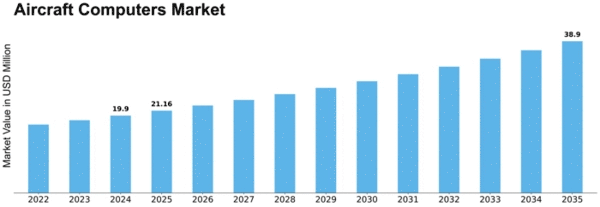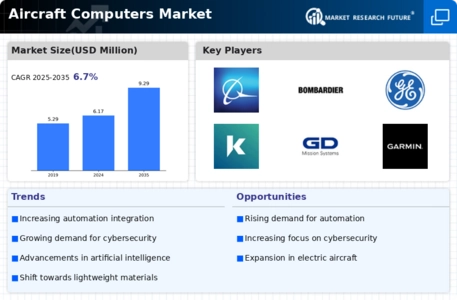-
Executive Summary
-
Market Attractiveness Analysis
- Global Aircraft Computers Market, by End User
- Global Aircraft
-
Computers Market, by Type
-
Global Aircraft Computers Market, by Platform
-
Global Aircraft Computers Market, by Component
-
Global Aircraft
-
Computers Market, by Region
-
Market Introduction
-
Market Definition
-
Scope of the Study
-
Market Structure
-
Key Buying Criteria
-
Market Factor Indicator Analysis
-
Research Methodology
-
Research
-
Process
-
Primary Research
-
Secondary Research
-
Market
-
Size Estimation
-
Forecast Model
-
List of Assumptions
-
Market
-
Insights
-
Market Dynamics
-
Introduction
-
Drivers
- Rising
- Modernization
- Drivers Impact Analysis
-
Increasing use of computers and electronic systems in aircraft
-
demand for aircraft computers in unmanned aerial vehicles
-
of existing aircraft fleet
-
Restraints
- Issues related to cyber-attacks
- Existing backlogs in aircraft
- Stringent aviation standards
- Restraints Impact
-
deliveries
-
Analysis
-
Opportunities
-
Market/Technological Trends
-
Patent Trends
-
Regulatory Landscape/Standards
-
Market Factor Analysis
-
Supply Chain Analysis
- R&D
- Manufacturing
- Post-Sales Monitoring
-
Distribution & Sales
-
Porter’s
- Threat of New Entrants
- Bargaining Power
- Bargaining Power of Buyers
- Threat of Substitutes
- Intensity of Rivalry
-
Five Forces Analysis
-
of Suppliers
-
Global Aircraft Computers Market, by End User
-
Introduction
-
OEM
-
Aftermarket
-
Global Aircraft
-
Computers Market, by Type
-
Introduction
-
Flight Controls
-
Flight Management Computers
-
Engine Controls
-
Utility Controls
-
Mission Computers
-
Global Aircraft Computers Market, by Platform
-
Introduction
-
Fixed Wing
-
Rotary Wing
-
UAV
-
Global Aircraft Computers Market, by Component
-
Introduction
-
Hardware
-
Software
-
Global Aircraft Computers Market,
-
by Region
-
Introduction
-
North America
- US
-
Canada
-
Europe
- UK
- Germany
- France
- Italy
- Russia
- Rest of Europe
-
Asia-Pacific
- China
- India
- Japan
- South Korea
- Rest of Asia-Pacific
-
Rest of the World
- Latin America
- Middle East & Africa
-
Competitive Landscape
-
Competitive
-
Overview
-
Competitor Dashboard
-
Major Growth Strategies in the
-
Global Aircraft Computers Market
-
Competitive Benchmarking
-
Market Share Analysis
-
Leading Player in Terms of Number of Developments
-
in the Global Aircraft Computers Market
-
Key Developments & Growth
- Product Launches/Service Deployments
- Mergers&Acquisitions
- Joint Ventures
-
Strategies
-
Company Profiles
-
Key Market Players
-
(Company overview, products & services offered, financial overview, key developments,
-
SWOT analysis, and key strategies to be covered for public companies)
-
Boeing
-
Bombardier Inc.
-
GE Aviation
-
Kontron S&T
-
AG
-
General Dynamics Mission Systems, Inc.
-
Garmin Ltd.
-
BAE Systems
-
Cobham Limited
-
Curtiss-Wright Corporation
-
Esterline Technologies
-
Other Prominent Players
-
Saab
-
AB
-
Raytheon Technologies Corporation
-
Thales Group
-
Honeywell International, Inc.
-
Safran
-
Appendix
-
References
-
Related Reports
-
List of Abbreviations
-
-
List of
-
Tables
-
List of Assumptions
-
Major Patents Granted for Aircraft
-
Computers (2020-2030)
-
Global Aircraft Computers Market, by End User,
-
Global Aircraft Computers Market, by Type,
-
Global Aircraft Computers Market, by Platform,
-
Global Aircraft Computers Market, By Component,
-
Global Aircraft Computers Market, by Region,
-
North America: Aircraft Computers Market, by
-
Country, 2020-2030(USD Million)
-
North America: Aircraft Computers Market,
-
by End User, 2020-2030 (USD Million)
-
North America: Aircraft Computers
-
Market, by Type, 2020-2030 (USD Million)
-
North America: Aircraft Computers
-
Market, by Platform, 2020-2030 (USD Million)
-
North America: Aircraft
-
Computers Market, By Component, 2020-2030 (USD Million)
-
US: Aircraft
-
Computers Market, by End User, 2020-2030 (USD Million)
-
US: Aircraft
-
Computers Market, by Type, 2020-2030 (USD Million)
-
US: Aircraft Computers
-
Market, by Platform, 2020-2030 (USD Million)
-
US: Aircraft Computers
-
Market, by Component, 2020-2030 (USD Million)
-
Canada: Aircraft Computers
-
Market, by End User, 2020-2030 (USD Million)
-
Canada: Aircraft Computers
-
Market, by Type, 2020-2030 (USD Million)
-
Canada: Aircraft Computers
-
Market, by Platform, 2020-2030 (USD Million)
-
Canada: Aircraft Computers
-
Market, by Component, 2020-2030 (USD Million)
-
Europe: Aircraft Computers
-
Market, by Country, 2020-2030 (USD Million)
-
Europe: Aircraft Computers
-
Market, by End User, 2020-2030 (USD Million)
-
Europe: Aircraft Computers
-
Market, by Type, 2020-2030 (USD Million)
-
Europe: Aircraft Computers
-
Market, by Platform, 2020-2030 (USD Million)
-
Europe: Aircraft Computers
-
Market, by Component, 2020-2030 (USD Million)
-
UK: Aircraft Computers
-
Market, by End User, 2020-2030 (USD Million)
-
UK: Aircraft Computers
-
Market, by Type, 2020-2030 (USD Million)
-
UK: Aircraft Computers Market,
-
by Platform, 2020-2030 (USD Million)
-
UK: Aircraft Computers Market,
-
by Component, 2020-2030 (USD Million)
-
Germany: Aircraft Computers
-
Market, by End User, 2020-2030 (USD Million)
-
Germany: Aircraft Computers
-
Market, by Type, 2020-2030 (USD Million)
-
Germany: Aircraft Computers
-
Market, by Platform, 2020-2030 (USD Million)
-
Germany: Aircraft Computers
-
Market, by Component, 2020-2030 (USD Million)
-
France: Aircraft Computers
-
Market, by End User, 2020-2030 (USD Million)
-
France: Aircraft Computers
-
Market, by Type, 2020-2030 (USD Million)
-
France: Aircraft Computers
-
Market, by Platform, 2020-2030 (USD Million)
-
France: Aircraft Computers
-
Market, by Component, 2020-2030 (USD Million)
-
Italy: Aircraft Computers
-
Market, by End User, 2020-2030 (USD Million)
-
Italy: Aircraft Computers
-
Market, by Type, 2020-2030 (USD Million)
-
Italy: Aircraft Computers
-
Market, by Platform, 2020-2030 (USD Million)
-
Italy: Aircraft Computers
-
Market, by Component, 2020-2030 (USD Million)
-
Russia: Aircraft Computers
-
Market, by End User, 2020-2030 (USD Million)
-
Russia: Aircraft Computers
-
Market, by Type, 2020-2030 (USD Million)
-
Russia: Aircraft Computers
-
Market, by Platform, 2020-2030 (USD Million)
-
Russia: Aircraft Computers
-
Market, by Component, 2020-2030 (USD Million)
-
Rest of Europe: Aircraft
-
Computers Market, by End User, 2020-2030 (USD Million)
-
Rest of Europe:
-
Aircraft Computers Market, by Type, 2020-2030 (USD Million)
-
Rest of
-
Europe: Aircraft Computers Market, by Platform, 2020-2030 (USD Million)
-
TABLE
-
Rest of Europe: Aircraft Computers Market, by Component, 2020-2030 (USD Million)
-
Asia-Pacific: Aircraft Computers Market, by Country, 2020-2030 (USD Million)
-
Asia-Pacific: Aircraft Computers Market, by End User, 2020-2030 (USD
-
Million)
-
Asia-Pacific: Aircraft Computers Market, by Type, 2020-2030
-
(USD Million)
-
Asia-Pacific: Aircraft Computers Market, by Platform,
-
Asia-Pacific: Aircraft Computers Market, by
-
Component, 2020-2030 (USD Million)
-
China: Aircraft Computers Market,
-
by End User, 2020-2030 (USD Million)
-
China: Aircraft Computers Market,
-
by Type, 2020-2030 (USD Million)
-
China: Aircraft Computers Market,
-
by Platform, 2020-2030 (USD Million)
-
China: Aircraft Computers Market,
-
by Component, 2020-2030 (USD Million)
-
India: Aircraft Computers Market,
-
by End User, 2020-2030 (USD Million)
-
India: Aircraft Computers Market,
-
by Type, 2020-2030 (USD Million)
-
India: Aircraft Computers Market,
-
by Platform, 2020-2030 (USD Million)
-
India: Aircraft Computers Market,
-
by Component, 2020-2030 (USD Million)
-
Japan: Aircraft Computers Market,
-
by End User, 2020-2030 (USD Million)
-
Japan: Aircraft Computers Market,
-
by Type, 2020-2030 (USD Million)
-
Japan: Aircraft Computers Market,
-
by Platform, 2020-2030 (USD Million)
-
Japan: Aircraft Computers Market,
-
by Component, 2020-2030 (USD Million)
-
South Korea: Aircraft Computers
-
Market, by End User, 2020-2030 (USD Million)
-
South Korea: Aircraft
-
Computers Market, by Type, 2020-2030 (USD Million)
-
South Korea: Aircraft
-
Computers Market, by Platform, 2020-2030 (USD Million)
-
South Korea:
-
Aircraft Computers Market, by Component, 2020-2030 (USD Million)
-
Rest
-
of Asia-Pacific: Aircraft Computers Market, by End User, 2020-2030 (USD Million)
-
Rest of Asia-Pacific: Aircraft Computers Market, by Type, 2020-2030 (USD
-
Million)
-
Rest of Asia-Pacific: Aircraft Computers Market, by Platform,
-
Rest of Asia-Pacific: Aircraft Computers Market,
-
by Component, 2020-2030 (USD Million)
-
Rest of the World: Aircraft
-
Computers Market, by Region, 2020-2030 (USD Million)
-
Rest of the World:
-
Aircraft Computers Market, by End User, 2020-2030 (USD Million)
-
Rest
-
of the World: Aircraft Computers Market, by Type, 2020-2030 (USD Million)
-
TABLE
-
Rest of the World: Aircraft Computers Market, by Platform, 2020-2030 (USD Million)
-
Rest of the World: Aircraft Computers Market, by Component, 2020-2030
-
(USD Million)
-
Latin America: Aircraft Computers Market, by End User,
-
Latin America: Aircraft Computers Market,
-
by Type, 2020-2030 (USD Million)
-
Latin America: Aircraft Computers
-
Market, by Platform, 2020-2030 (USD Million)
-
Latin America: Aircraft
-
Computers Market, by Component, 2020-2030 (USD Million)
-
Middle East
-
& Africa: Aircraft Computers Market, by End User, 2020-2030 (USD Million)
-
Middle East & Africa: Aircraft Computers Market, by Type, 2020-2030
-
(USD Million)
-
Middle East & Africa: Aircraft Computers Market,
-
by Platform, 2020-2030 (USD Million)
-
Middle East & Africa: Aircraft
-
Computers Market, by Component, 2020-2030 (USD Million)
-
The Most Active
-
Players in the Global Aircraft Computers Market
-
Contracts & Agreements
-
Mergers & Acquisitions
-
Product/Service Developments
-
Expansions & Investments
-
Joint Ventures & Partnerships
-
-
List of Figures
-
Market Synopsis
-
Global
-
Aircraft Computers Market: Market Attractiveness Analysis
-
Global Aircraft
-
Computers Market Analysis, by End User
-
Global Aircraft Computers Market
-
Analysis, by Type
-
Global Aircraft Computers Market Analysis, by Platform
-
Global Aircraft Computers Market Analysis, by Component
-
Figure 7
-
Global Aircraft Computers Market Analysis, by Region
-
Global Aircraft
-
Computers Market: Market Structure
-
Key Buying Criteria for Aircraft
-
Computers Technologies
-
Research Process of MRFR
-
North
-
America: Market Size & Market Share, by Country, 2020 vs 2030
-
Figure 12
-
Europe: Market Size & Market Share, by Country, 2020 vs 2030
-
Figure 13
-
Asia-Pacific: Market Size & Market Share, by Country, 2020 vs 2030
-
Figure
-
Rest of the World: Market Size & Market Share, by Region, 2020 vs 2030
-
Market Dynamics Overview
-
Drivers Impact Analysis: Global
-
Aircraft Computers Market
-
Restraints Impact Analysis: Global Aircraft
-
Computers Market
-
Porter’s Five Forces Analysis of the Global
-
Aircraft Computers Market
-
Supply Chain: Global Aircraft Computers
-
Market
-
Global Aircraft Computers Market Share, by End User, 2020
-
(% Share)
-
Global Aircraft Computers Market Share, by Platform, 2020
-
(% Share)
-
Global Aircraft Computers Market Share, by Type, 2020 (%
-
Share)
-
Global Aircraft Computers Market Share, by Component, 2020
-
(% Share)
-
Global Aircraft Computers Market Share, by Region, 2020
-
(% Share)
-
North America: Aircraft Computers Market Share, by Country,
-
Europe: Aircraft Computers Market Share, by Country,
-
Asia-Pacific: Aircraft Computers Market Share, by
-
Country, 2020 (% Share)
-
Rest of the World: Aircraft Computers Market
-
Share, by Region, 2020 (% Share)
-
Competitor Dashboard: Global Aircraft
-
Computers Market
-
Capital Market Ratio and Financial Matrix
-
Figure
-
Contracts & Agreements: The Major Strategy Adopted by Key Players in the
-
Global Aircraft Computers Market
-
Benchmarking of Major Competitors
-
Major Service Providers Market Share Analysis, 2020


















Leave a Comment